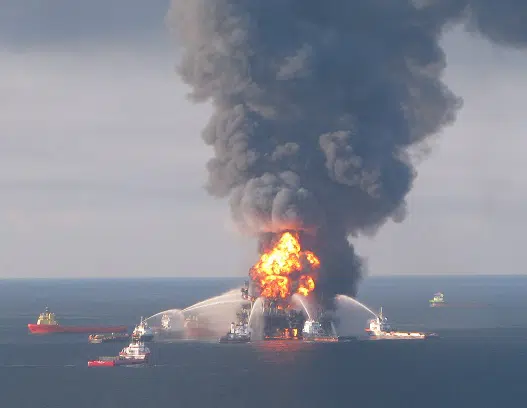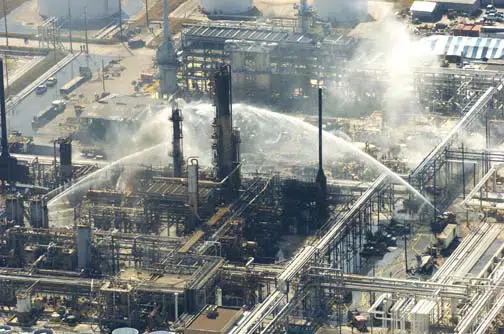Fire, intense heat, falling debris, structural failures, and the release of toxic materials are not the only deadly dangers of a refinery or oil rig explosion. When an explosion occurs in a refinery or on an offshore oil rig, it generates an invisible pressure wave that violently expands outwards in all directions. This pressure wave, also known as a blast wave, travels through the surrounding environment with incredibly destructive force.

In addition to a blast wave, a “blast wind” — a forced flow of superheated air — can also be generated during an explosion in a refinery or oil rig.
Depending on the energy released during the explosion, this pressure wave has the potential to literally pulverize anything in its path, including any workers unfortunate enough to be in close vicinity of the blast. These events are particularly dangerous because they have the capability to inflict life-threatening, multi-system injuries on several persons simultaneously.
What Are Blast Wave Injuries?
When a worker is struck by the blast wave from an explosion, the force can create a unique class of injury called an explosion or blast injury. Blast injuries are characterized by anatomical and physiological damage resulting from a direct or reflective over-pressurization force (such as the blast wave from an explosion) impacting the body’s surface. The two major factors that determine the severity of a blast injury are the victim’s proximity to the explosion and the force of the explosion.
According to the CDC, these types of injuries are normally only encountered during combat or a terrorist attack. Because these types of accidents happen so infrequently outside a combat setting, most civilian medical professionals lack the training and experience to effectively diagnose, treat, and manage blast injuries.
Four Types of Blast Injuries
Blast injuries are divided into four different classifications: primary, secondary, tertiary, and quaternary.
Primary
These are injuries caused when the over-pressurization force of the blast wave impacts the body surface. They generally affect the gas-filled structures of the body, such as the lungs, GI tract and middle ear.
Primary blast wave injuries are serious and can include blast lung (pulmonary barotrauma), TM rupture and damage to the middle ear, abdominal hemorrhage and perforation, globe (eyeball) rupture, and concussion (TBIs with no signs of external trauma).
Blast lung occurs when the force of the blast wave causes hemorrhaging and other damage to the lung, resulting in severe and even fatal respiratory difficulties and failure.
Secondary
Secondary blast injuries are injuries resulting from being struck by flying debris. They can cause penetrating and blunt injuries. Any part of the body can be affected.
Tertiary
These are injuries caused when a victim is thrown by the force of the blast. They can cause penetrating and blunt injuries, including bone fractures. Any part of the body can be affected.
Quaternary
These are explosion-related injuries not caused by the blast wave. These include burns, crush injuries, TBIs, problems related to smoke inhalation, etc. Any part of the body can be affected.
Examples of Blast Wave Injuries
Blast wave injuries can affect just about any part of the body. Blast wave related injuries can include:

Auditory injuries: TM rupture, ossicular disruption, cochlear damage, infiltration of foreign bodies
Circulatory injuries: Cardiac contusion, myocardial infarction from air embolism, shock, vasovagal hypotension, peripheral vascular injuries, air embolism-induced injuries
Central nervous system and brain injuries: Concussion, closed and open traumatic brain injuries, stroke, spinal cord injuries, air embolism-induced injuries
Digestive tract injuries: Bowel perforation, hemorrhage, sepsis, ruptured liver or spleen, mesenteric ischemia from air embolism
Extremity injuries: Burns, cuts, lacerations, amputations, disfigurement, fractures, crush injuries, compartment syndrome, acute arterial occlusion, air embolism-induced injury
Eye, orbit, face injuries: Perforated globe (eyeball), foreign body penetration, air embolism, orbital fractures
Renal injuries: Renal contusion, laceration, hypotension, hypovolemia, and acute renal failure due to rhabdomyolysis
Respiratory injuries: Blast lung (pulmonary barotrauma), hemothorax, pneumothorax, pulmonary contusion and hemorrhage, A-V fistulas (source of air embolism), airway epithelial damage, aspiration pneumonitis, sepsis
Don’t Wait to Seek Medical Attention After Being Exposed to a Blast Wave
If you’ve been struck by the blast wave or blast wind resulting from a refinery or offshore oil rig explosion, it’s important to seek immediate medical treatment, even if you don’t think you’ve been injured.
Due to the internal nature of many blast wave injuries, it may be hours before a victim begins to experience pain and other symptoms of their injuries. In some cases, it can take as long as 48 hours for the symptoms of blast lung to appear. This can create a dangerous delay in treatment situations.
Protect Your Rights After a Refinery or Offshore Oil Rig Explosion
The companies that own and operate the nation’s refineries and oil rigs have a legal obligation to provide their workers with a safe working environment. When they fail to do so, explosions, fires and other accidents can occur. Oil rig and refinery accidents often result in serious, even fatal injuries. These injuries can cause costly and life-changing damages, such as:
If you were injured in an explosion at a refinery or oil rig that happened because of the negligent actions of an employer or co-worker, you have a right to seek compensation for the damages caused by your injuries.
The first step to collecting this compensation is to call the law firm of Lambert Zainey Smith & Soso. We’ve been protecting the rights of injured refinery, oil field and offshore oil rig workers for nearly half a century. Our legal knowledge, expertise, and dedication to protecting our clients’ interests have enabled us to obtain more than a billion dollars in settlements for our clients.
Contact Lambert Zainey through our website or call us at (800) 521-1750 to speak with a leading refinery and maritime injury attorney about your explosion and blast wave-related injuries.
